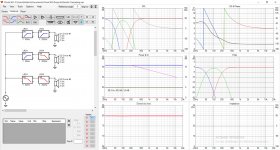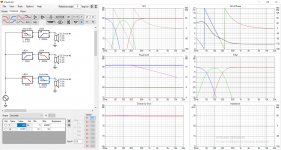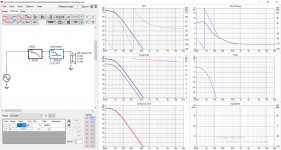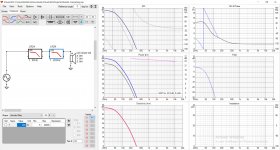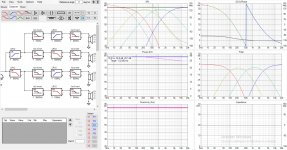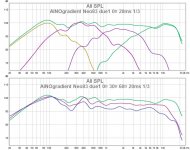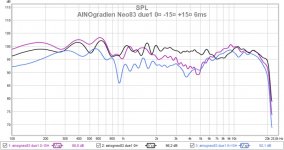Correct, putting a decade between crossover points will prevent this problem. SL showed an example with only 2 octaves separation.Robintipp said:Then this happened.
This can be done with no channel cascading, no EQ and only one extra filter. Are you interested?
Attachments
Thanks Alen,
Sure am interested.
The example you posted shows both cascading and paralleling + all-pass works even when mixing them.
So I've split them up to see what could be different...
I couldn't spot them this way.
Sure am interested.
The example you posted shows both cascading and paralleling + all-pass works even when mixing them.
So I've split them up to see what could be different...
I couldn't spot them this way.
Attachments
Nailed it.
Only one of the lower two is correct, the one with the all-pass filters. Linkwitz has it summed up with this
Only one of the lower two is correct, the one with the all-pass filters. Linkwitz has it summed up with this
Just for fun, here is a version with the tweeter polarity inverted.SL said:A maximally flat response is obtained when also the 200 Hz lowpass filter phase shift in the W channel is duplicated in the SW channel by an allpass filter with the same phase response.
Attachments
Back to the original question. My guess is simply, that the previous pair of speakers was poor, with phase issue!
A pair of stereo speakers shoud image prescisely without any "depth" illusion - unless there is some tricks done in the recording (eg. Pink Floyd). Some classical recordings may replay 3D space cues, with headphones! All of the depth we hear comes from reflections and interferences in the room!
A good test of issues with phase between a pair of speakers is to play monophonic signal, eg. pink noise of speech from radio. Image sould be sharp in the middle, but often eg. s's of speech are heard differently. This is preferably a room issue, not a fault in speakers.
It has happened several times to me and diy friends, that just one module of a pair of multiway speakers has wrong polarity, and this takes some time to hear! Then we hear depth, but in an unpleasant eery way!
Creating A Sense Of Depth In Your Mix
A pair of stereo speakers shoud image prescisely without any "depth" illusion - unless there is some tricks done in the recording (eg. Pink Floyd). Some classical recordings may replay 3D space cues, with headphones! All of the depth we hear comes from reflections and interferences in the room!
A good test of issues with phase between a pair of speakers is to play monophonic signal, eg. pink noise of speech from radio. Image sould be sharp in the middle, but often eg. s's of speech are heard differently. This is preferably a room issue, not a fault in speakers.
It has happened several times to me and diy friends, that just one module of a pair of multiway speakers has wrong polarity, and this takes some time to hear! Then we hear depth, but in an unpleasant eery way!
Creating A Sense Of Depth In Your Mix
Last edited:
Some information on the early device used by Pink Floyd: Azimuth Co-ordinator - Wikipedia
About the phase issue, I experienced it too when I made a polarity error on one of the midrange. Some sounds seemed to appear coming from centre behind me. I used steep (LR8) crossover slopes in 6-way speaker so it wasn't until I measured and saw the deep nulls that I realised what was happening.
About the phase issue, I experienced it too when I made a polarity error on one of the midrange. Some sounds seemed to appear coming from centre behind me. I used steep (LR8) crossover slopes in 6-way speaker so it wasn't until I measured and saw the deep nulls that I realised what was happening.
OK, Thanks to everyone for their input. Much of the discussions about phase was waay over my head but thanks and I'm sure it helped someone.
The whole truth and nothing but...
As previously stated built these about 3 yrs ago, and then 2 yrs tinkering with the xovers AND POSITIONING.
I finally gave into swmbo and finished the cabinets. I laminated them. To preserve the positioning I put masking tape on the floor so I KNOW they went back in the same place.
I guess this is starting to sound familiar to some...
Thats when I had the problem. The speakers were totally invisible. The sound appeared to be emanating from an invisible screen 15-18 inches in front of the speakers. I was confused to say the least.
The speakers are now about 30" from the back wall rather than the 38-40" that they were, and sound wonderful.
I'm totally stunned that laminating the cabinets could make such drastic changes in sound,
but maybe I shouldn't be really as I am well aware that just 3/4in movement in any direction of the speakers in my room is noticible.
So has the answer got to be the change in diffraction?
The whole truth and nothing but...
As previously stated built these about 3 yrs ago, and then 2 yrs tinkering with the xovers AND POSITIONING.
I finally gave into swmbo and finished the cabinets. I laminated them. To preserve the positioning I put masking tape on the floor so I KNOW they went back in the same place.
I guess this is starting to sound familiar to some...
Thats when I had the problem. The speakers were totally invisible. The sound appeared to be emanating from an invisible screen 15-18 inches in front of the speakers. I was confused to say the least.
The speakers are now about 30" from the back wall rather than the 38-40" that they were, and sound wonderful.
I'm totally stunned that laminating the cabinets could make such drastic changes in sound,
but maybe I shouldn't be really as I am well aware that just 3/4in movement in any direction of the speakers in my room is noticible.
So has the answer got to be the change in diffraction?
A pair of stereo speakers shoud image prescisely without any "depth" illusion - unless there is some tricks done in the recording (eg. Pink Floyd). Some classical recordings may replay 3D space cues, with headphones! All of the depth we hear comes from reflections and interferences in the room!
Almost all recordings have some depth to them. Reverberation is often used in mixing.
This is a good example of both with and without:
YouTube
The keyboard has some measure of depth, the vocals don't (or very close to that) - and in fact it's pretty rare for vocals on a good recording to lack some amount of depth.
I've gotten to hate this track from Rod (though even then it was never a favorite even if it is a good song), because I use it so often for image placement (..due to the way it introduces various "sources"):
YouTube
-this song along with real-time freq. response measurements showed me that fullrange driver's with "whizzer" cones were screwing up placement with added sources or "signal complexity" - typically referenced as sounding "confused" with complex material. This was almost exclusively because linearity within the "whizzer's" pass-band was constantly changing (relative to the signal or a more typical multi-way's result).
Last edited:
Wow haven't heard those in a long time, thanks.
YouTube
Try this as an alternative for the Rod Stewart song.
Some of these have me asking myself if they are recorded in SQ (quadraphonic) and we are trying to build speakers that are able to decode SQ by means of accoustics.
YouTube
Try this as an alternative for the Rod Stewart song.
Some of these have me asking myself if they are recorded in SQ (quadraphonic) and we are trying to build speakers that are able to decode SQ by means of accoustics.
Nailed it.
Only one of the lower two is correct, the one with the all-pass filters. Linkwitz has it summed up with this
Just for fun, here is a version with the tweeter polarity inverted.
Playing around with VCAD is fun, but have strong doubts that the image I attached could be translated into the real world.
All LR12 slopes, IIR..
Not possible... Right?
Attachments
Prefer to stay stay with IIR, but the introduced phase rotations I'd like to eliminate.
I have read about forward-backward filtering. Unfortunately can't find any reference to programs that can do that kind of filtering for audio yet.
But before I go searching...
Reversing the audio sample to filter it, then reversing it again. Does the post-ringing of the reversed sample turn up as pre-ringing after reversing it again?
If so, is this in the same order of magnitude as with a FIR filter that has the same slopes? No free lunch I'd guess..
Thanks for your answers.
I have read about forward-backward filtering. Unfortunately can't find any reference to programs that can do that kind of filtering for audio yet.
But before I go searching...
Reversing the audio sample to filter it, then reversing it again. Does the post-ringing of the reversed sample turn up as pre-ringing after reversing it again?
If so, is this in the same order of magnitude as with a FIR filter that has the same slopes? No free lunch I'd guess..
Thanks for your answers.
Attachments
I haven't learned FIR, my 4-way Ainos have IIR LR2/ellipitic acoustic xo setting with minidsp 4x10Hd.
It is risky to measure/ analyze in-room, but the challenge is to have control of each driver's response and delay so that phases of woofer and tweeter match and sum below the mid. This can be tested by muting the mid and measuring. Phase will rotate inevitably, but softly with LR2 or Duelund.
My indoor measurements, also vertical off-axis
It is risky to measure/ analyze in-room, but the challenge is to have control of each driver's response and delay so that phases of woofer and tweeter match and sum below the mid. This can be tested by muting the mid and measuring. Phase will rotate inevitably, but softly with LR2 or Duelund.
My indoor measurements, also vertical off-axis
Attachments
Hi All,
I embarked on this projet 3 yrs ago having spent nearly a year reading this forum. There is so much knowledge here I cant begin to explain how humble I feel.
Anyway I built a three way with the Peerless 830452, SB satori 16mw8, and sb29rdc, crossed at approx 120 and 1800Hz. I designed the crossovers (many thanks to AllenB and Bwaslo) .
I have now reached a point where the speakers are totally and I mean totally invisible, BUT the downside is that the soundstage is two dimensional, and has no (illusion) of depth. is this something that can be designed in or does the speakers disappearing act kinda preclude that... one or the other?
I deliberately haven't posted any circuits etc yet cos I want to learn
many thanks
Andrew
Hello,
It is amazing how similar 2 speaker stereo systems begin to sound when frequency response curves, phase, directivity, direct sound vs delayed reflected sound, room power curves and RT are all dialed in.
Correctly placed speakers away from the room boundaries and room reflections with measured delays will contribute to the sense of space and depth. You need the use of quality test equipment and software.
I believe that Linkwitz is correct. The sense of space and depth is an illusion. DSP and multiple speakers can create the illusion but that is not stereo in the traditional sense.
Some would say that engineered reflections and delays are distortions.
Thanks DT
...Correctly placed speakers away from the room boundaries and room reflections with measured delays will contribute to the sense of space and depth. You need the use of quality test equipment and software.
I believe that Linkwitz is correct. The sense of space and depth is an illusion. DSP and multiple speakers can create the illusion but that is not stereo in the traditional sense.
Some would say that engineered reflections and delays are distortions
+1. But "sense of space and depth" are valuable HiFi virtues (esp that dipole listeners cherish) but are not the same as the ability to correctly assess depth even relatively.
Would we say an oil painting of a cow has depth? The answer is, of course, yet and no. Some of the cues are present but on the other hand, it is just bits of paint on a piece of canvas. The only veridical perception is you are looking at a flat piece of canvas. But we can see the cow too.
There are some legitimate cues to depth in a purist recording and even some sort-of legitimate cues in the all-but-universal cooked studio pastiche. In other words, those that are pontificating in this thread about how to hear perfect 3D sound, are forgetting that it is a perception in their mind and not something that can actually be found on their two tracks.
Is stereo an unimportant "parlour trick"?
B.
Last edited:
Well if width is perceived and the speakers appear to be invisible, I can imagine some accoustical tweaking may possibly improve perception, or at least change it.
@bentoronto: Have you ever seen the oil painting of the white cow in the fog? Funny story, I never got to know the original artist. It's embedded in some word processing programs as a hidden easter egg. If you want to know more about it, just send me a PM. Just leave it empty, I'll just return it to you.
@bentoronto: Have you ever seen the oil painting of the white cow in the fog? Funny story, I never got to know the original artist. It's embedded in some word processing programs as a hidden easter egg. If you want to know more about it, just send me a PM. Just leave it empty, I'll just return it to you.
this depth thing, is it not a tweeter dispersion thing? small monitors with small baffles are always image champs in loudspeaker reviews, the small baffle makes the tweeter output frequencies easier to wrap around the baffle and reflect in the wall behind the speaker, these reflections fools our brain and the stereo image in front of us becomes more credible.
so, using a ring radiator tweeter on a big baffle enclosure is a big mistake if you want an image champion, all you can do here to rescue the project is to add ambience tweeter(s)
so, using a ring radiator tweeter on a big baffle enclosure is a big mistake if you want an image champion, all you can do here to rescue the project is to add ambience tweeter(s)
this depth thing, is it not a tweeter dispersion thing? small monitors with small baffles are always image champs in loudspeaker reviews, the small baffle makes the tweeter output frequencies easier to wrap around the baffle and reflect in the wall behind the speaker, these reflections fools our brain and the stereo image in front of us becomes more credible.
so, using a ring radiator tweeter on a big baffle enclosure is a big mistake if you want an image champion, all you can do here to rescue the project is to add ambience tweeter(s)
Is it a tweeter dispersion thing? No i don't think so: It is a diffraction thing. The 'small baffle monitors' have dimensions which make the diffraction within frequency range which give this 'impression' of pinpoint imaging.
Celef i think your description of the tweeter behavior regarding dispersion is flawed. What you describe is true for lower freq ( and is indeed what happens regarding BSC, but from let's say 1 to 4khz ( more or less the usable xover point of tweeters ) it doesn't hold true anymore.
The question is more for me does a pin point imaging exist in real life or through the use of a pair of microphone ( reproduced by loudspeakers or headphones ( prerequisite for a 'dummy head' microphone couple))?
Some food for thought:
Infinite-baffle
- Status
- This old topic is closed. If you want to reopen this topic, contact a moderator using the "Report Post" button.
- Home
- Loudspeakers
- Multi-Way
- crossover design- depth of field

